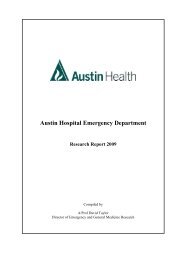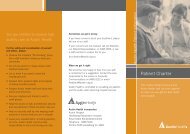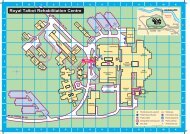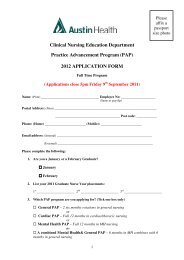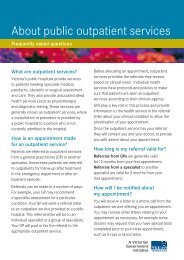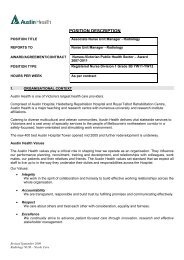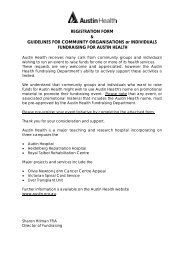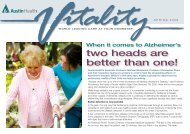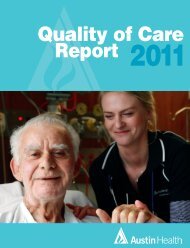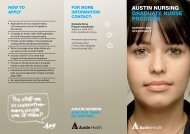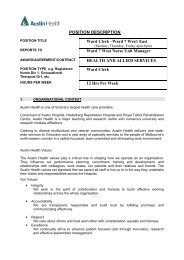Royal Talbot Rehabilitation Centre - Student ... - Austin Health
Royal Talbot Rehabilitation Centre - Student ... - Austin Health
Royal Talbot Rehabilitation Centre - Student ... - Austin Health
Create successful ePaper yourself
Turn your PDF publications into a flip-book with our unique Google optimized e-Paper software.
<strong>Royal</strong> <strong>Talbot</strong> <strong>Rehabilitation</strong> <strong>Centre</strong>Dear 2009 <strong>Student</strong>,Welcome to <strong>Royal</strong> <strong>Talbot</strong> <strong>Rehabilitation</strong> <strong>Centre</strong>!You will find attached a package of materials with various pieces of information.The contents aim to optimise your preparation for your placement here at <strong>Royal</strong><strong>Talbot</strong>.For third year, fourth year and masters students, we encourage you to completethe Pre-placement Learning Package. Please contact me and I will email you acopy of the package.This Package includes:- Information about Speech Pathology services at <strong>Royal</strong> <strong>Talbot</strong> <strong>Rehabilitation</strong><strong>Centre</strong>- A list of general expectations – you will receive more details at thebeginning of your placement- A Speech Pathology Report Template- A list of useful readings for the placement- A Confidentiality Deed to look through (you will need to sign it on the firstday of your placement)- Information about parking & limited public transport (you will need todownload the map of <strong>Royal</strong> <strong>Talbot</strong> <strong>Rehabilitation</strong> <strong>Centre</strong> via the <strong>Austin</strong><strong>Health</strong> website)At some point during your placement, we may ask you to give us feedback abouthow useful this package was to you and how you feel it could be improved.We look forward to having you on our team for the duration of your placement!Yours sincerely,Tracy LoweSpeech Pathologist & Clinical Education Coordinator<strong>Royal</strong> <strong>Talbot</strong> <strong>Rehabilitation</strong> <strong>Centre</strong><strong>Austin</strong> <strong>Health</strong>Ph: 03 9490 7581Email: tracy.lowe@austin.org.au
<strong>Royal</strong> <strong>Talbot</strong> <strong>Rehabilitation</strong> <strong>Centre</strong>About Speech Pathology at<strong>Royal</strong> <strong>Talbot</strong> <strong>Rehabilitation</strong> <strong>Centre</strong>What Speech Pathologists at <strong>Royal</strong> <strong>Talbot</strong> <strong>Rehabilitation</strong> <strong>Centre</strong> do:Speech Pathologists at <strong>Royal</strong> <strong>Talbot</strong> <strong>Rehabilitation</strong> <strong>Centre</strong> work with adults, theirfamilies, friends and staff to:• Optimise communication• Assist people to eat and drink safely and with optimal enjoyment.We work with people with a wide range of needs. These needs may includesupport and / or intervention to:• Use methods other than speech to communicate.• Speak more clearly.• Understand or remember what is said to them.• Think of words they want to use in conversation.• Put words together in a sentence.• Plan, organise and / or focus their attention when communicating.• Understand complex written material.• Eat and drink safely.Things you can do to support communication:If you can’t understand what the person says or they seem not to understand:• Stay calm.• Find a quiet place with no noise, no people rushing.• Take time to speak slowly and listen carefully and wait for the message.• Talk one at a time; a group conversation is hard.• Watch the person for face, hands and body for cues. Use gesture andfacial expression yourself.• Make sure you both know the topic you are talking about; follow theperson’s lead, don’t change the subject suddenly.• Know how the person communicates best – the speech pathologist mayhave made recommendations in the file, or you can ask her.• Book an interpreter if the person uses a language other than English (ext3367).
<strong>Royal</strong> <strong>Talbot</strong> <strong>Rehabilitation</strong> <strong>Centre</strong>Speech Pathology Services at <strong>Royal</strong> <strong>Talbot</strong> <strong>Rehabilitation</strong> <strong>Centre</strong>Neurology Unit: Ward based service for people involved in rehabilitation followingneurological events.Spinal Unit: Ward-based service for people involved in rehabilitation following aspinal cord injuryAcquired Brain Injury Service: A secure ward for people who have had a recentbrain injury, e.g. closed head injuryBrain Disorders Program: A service for people with brain injuries and psychiatricneeds. It includes a secure accommodation unit and community servicesOrthopaedic and Amputee Unit: Ward-based service for people involved inrehabilitation following orthopaedic surgery or amputationsAmbulatory Services: For people involved in rehabilitation in the home or asoutpatients
<strong>Royal</strong> <strong>Talbot</strong> <strong>Rehabilitation</strong> <strong>Centre</strong>Speech Pathology DepartmentGeneral Expectations of <strong>Student</strong>s• To arrive punctually at time(s) arranged with supervising clinician(s)• To wear appropriate attire and name badge at all times• To read and sign a copy of the confidentiality deed prior to beinginvolved with clients or hearing / reading any specific clientinformation• To complete the student orientation checklist by the end of your firstday• To complete the student learning agreement on your first morning• To be familiar with terminology relating to communication disordersof neurological origin (excluding 1 st year observation students)• To complete a written evaluation at the conclusion of the placement
<strong>Royal</strong> <strong>Talbot</strong> <strong>Rehabilitation</strong> <strong>Centre</strong>SPEECH PATHOLOGY ASSESSMENT REPORTSPEECH PATHOLOGIST:DATE:DATE OF ADMISSION TO ROYAL TALBOT:MEDICAL DIAGNOSIS:LANGUAGE (S) SPOKEN:REFERRING AGENCY:OCCUPATION:LANGUAGE ______________________________________________NAD/IMPAIREDAuditory Comprehension:Verbal Expression:READING, WRITING _______________________________________ NAD/IMPAIREDCOGNITIVE-LANGUAGE SKILL________________________________ NAD/IMPAIREDVerbal Planning:Verbal memory:Attention/Repetition:Verbal Problem Solving:Verbal Explanation:CONVERSATIONAL SKILLS/FUNCTIONAL COMMUNICATION SKILLS __ NAD/IMPAIRED___________________________________________________________________________________MOTOR SPEECH, SWALLOWING ______________________________NAD/IMPAIRED___________________________________________________________________________________OTHER: HEARING, PATIENT PERCEPTION___________________________________________________________________________________SUMMARY AND SPEECH PATHOLOGY MANAGEMENTSPEECH PATHOLOGISTPh: 9490 -
<strong>Royal</strong> <strong>Talbot</strong> <strong>Rehabilitation</strong> <strong>Centre</strong>References in our Resources Roomwhich may be of particular use during your placementBeukelman, D. and Mirenda, P. (1998). Augmentative and AlternativeCommunication: Management of Severe Communication Disorders in Childrenand Adults (2 nd Edn.). Paul H. Brookes: Baltimore.Chapey, R. (Ed). (1986). Language intervention Strategies in Adult Aphasia.Williams & Wilkins: Baltimore.Duffy, J. (2005). Motor Speech Disorders: Substrates, Differential Diagnosis andManagement (2 nd Edn.). Elsevier Mosby: St. Louis.Hecaen, H. and Albert, M. (1978). Human Neuropsychology. John Wiley & Sons:New York.Joanette, Y; Goulet, P; Hannequin, D. (1990). Right Hemisphere and VerbalCommunication. Springer-Verlag: New York.Logemann, J. (1998). Evaluation and Treatment of Swallowing Disorders. Pro-ed:<strong>Austin</strong>, Texas.Pound, C; Parr, S; Lindsay, J; Woolf, C. (2000). Beyond Aphasia: Therapies forLiving with Communication Disability. Speechmark: Bicester, UK.Reilly, S; Douglas, J; and Oates, J. (2004). Evidence Based Practice in SpeechPathology. Whurr: London.Schwartz, S. (2004). The Sourcebook of Voice Disorders. Linguisystems: EastMoline, IL.Square-Storer, P. (Ed.) (1998). Acquired apraxia of speech in aphasic adults.Taylor & Francis: London.
<strong>Royal</strong> <strong>Talbot</strong> <strong>Rehabilitation</strong> <strong>Centre</strong>Assessment tools commonly used by Speech Pathologistsat <strong>Royal</strong> <strong>Talbot</strong> <strong>Rehabilitation</strong> <strong>Centre</strong>(also in our Resources Room)Bayles, K. and Tomoeda, C. (1993). Arizona Battery for CommunicationDisorders of Dementia. Canyonlands Publishing: Tucson.Enderby, P. (1983). Frenchay Dysarthria assessment. College Hill Press: SanDiego.Goodglass, H. and Kaplan, E. (1983). The Assessment of Aphasia and RelatedDisorders (2 nd Edn.). Lea & Febiger: Philedelphia (Boston DiuagnosticAphasiaExamination – BDAE)Goodglass, H., Kaplan, E. and Weintraub, S. (1983). Boston Naming Test. Lea &Febiger: PhiledelphiaKay, J., Lesser, R. and Coltheart, M. (1992). Psycholinguistic Assessments ofLanguage Processing in Aphasia (PALPA). Lawrence Erlbaum: Hove, U.K.Kertesz, A. (1982). The Western Aphasia Battery. Harcourt Brace Jovanovich.Willinck, L. (1996). Willinck Assessment of Neglect Dyslexia and AfferentDysgraphia (WANDD). Speech Pathology Department, Caulfield General Medical<strong>Centre</strong>: Caulfield, Australia.
<strong>Royal</strong> <strong>Talbot</strong> <strong>Rehabilitation</strong> <strong>Centre</strong>CONFIDENTIALITY DEEDAs a student/employee ofSpeech PathologyYou are bound by the laws that apply to <strong>Austin</strong> <strong>Health</strong>, including relevant privacylegislation as well as <strong>Austin</strong> <strong>Health</strong> By-Laws and policies, which are varied fromtime to time. A copy of these can be viewed in the department where you arelocated. This includes the agreement not to revel to any person or entity anyconfidential information relating to patients, employees, policies, processes anddealings.You are asked to read and sign this document, agreeing to observe strictconfidentiality relating to ALL informationIunderstand that allinformation I handle is to be treated in the strictest confidence and I agree toobserve related Acts, policies and By-Laws of <strong>Austin</strong> <strong>Health</strong>. I also understandthat I should only access and use personal information to the extent required bymy role/placementSigned Dated / /Witness Dated / /
<strong>Royal</strong> <strong>Talbot</strong> <strong>Rehabilitation</strong> <strong>Centre</strong>Getting to <strong>Royal</strong> <strong>Talbot</strong> <strong>Rehabilitation</strong> <strong>Centre</strong>!<strong>Royal</strong> <strong>Talbot</strong> <strong>Rehabilitation</strong> <strong>Centre</strong> is located at 1 Yarra Boulevard,Kew. It is just off the Chandler Highway and is opposite the GuideDogs. You can find a map of <strong>Royal</strong> <strong>Talbot</strong> <strong>Rehabilitation</strong> <strong>Centre</strong> underLocation Maps on the bottom toolbar of the <strong>Austin</strong> <strong>Health</strong> website.By CarIf you are driving to <strong>Royal</strong> <strong>Talbot</strong> <strong>Rehabilitation</strong> <strong>Centre</strong>, you have twooptions for parking:- you can park on site which costs $2 per day - there is a coinoperated boom gate and you will need the exact money toenteror;- you can park on Yarra Boulevard which is free.By BusIf you are catching a bus, Dysons operate a bus service which runsbetween Cotham Rd Kew, <strong>Royal</strong> <strong>Talbot</strong> <strong>Rehabilitation</strong> <strong>Centre</strong> andFairfield Station. Please contact us if you think you will be catchingthe bus and we can send you out the timetable. You are alsowelcome to look up the information on the Dysons website.By TrainIf you are catching the train, the closest train station is Alphingtontrain station and then <strong>Royal</strong> <strong>Talbot</strong> <strong>Rehabilitation</strong> <strong>Centre</strong> isapproximately a 20-25 minute walk from there. Alternatively, youcould catch the train to Fairfield and then the bus from Fairfieldstation to <strong>Royal</strong> <strong>Talbot</strong> <strong>Rehabilitation</strong> <strong>Centre</strong>.
<strong>Royal</strong> <strong>Talbot</strong> <strong>Rehabilitation</strong> <strong>Centre</strong>Pre-placement package feedback1. What was useful to you in this package?2. What was not useful?3. What else would you like to had included that would havehelped your orientation?’4. Would a different format of anything been useful?



